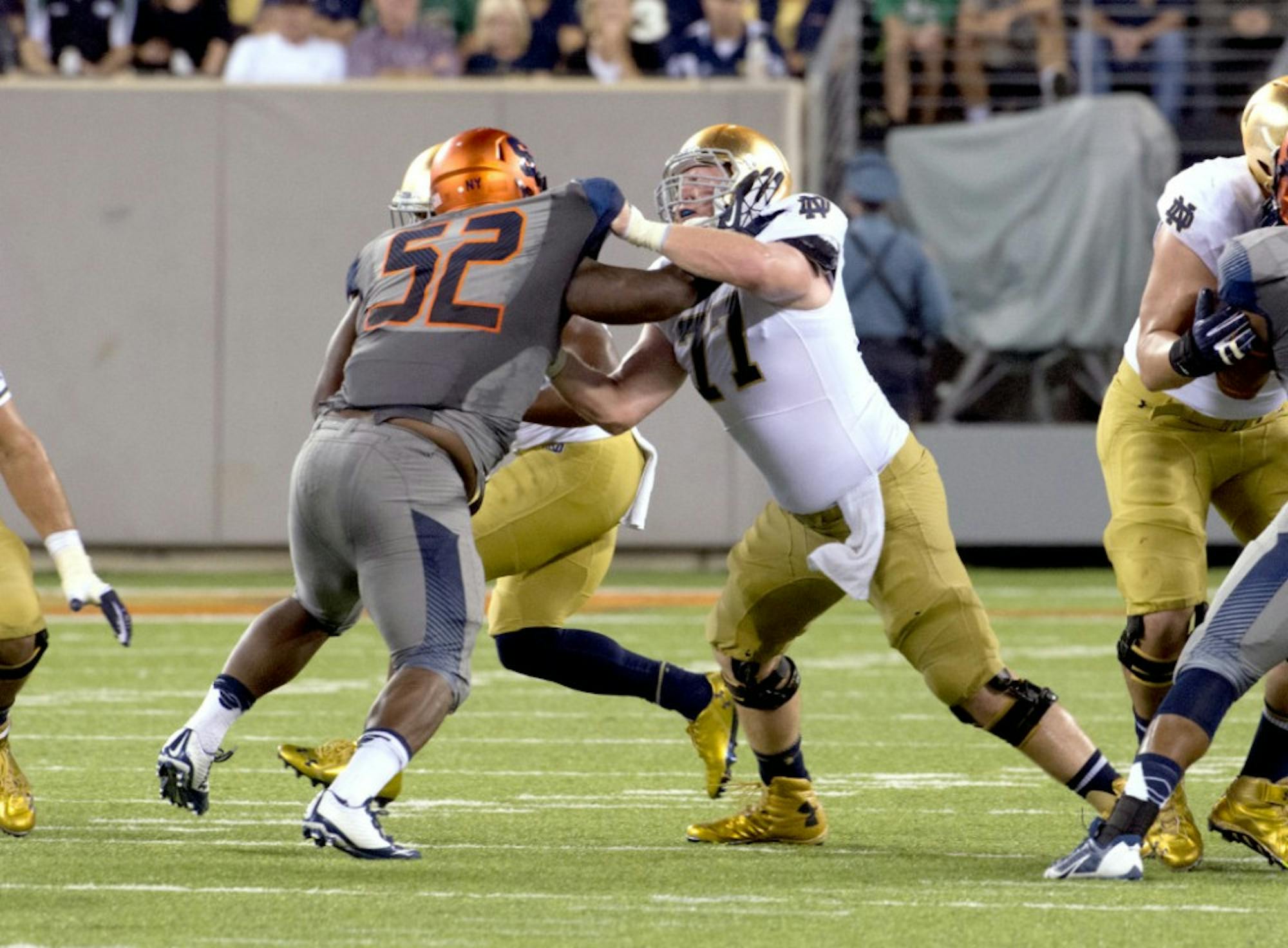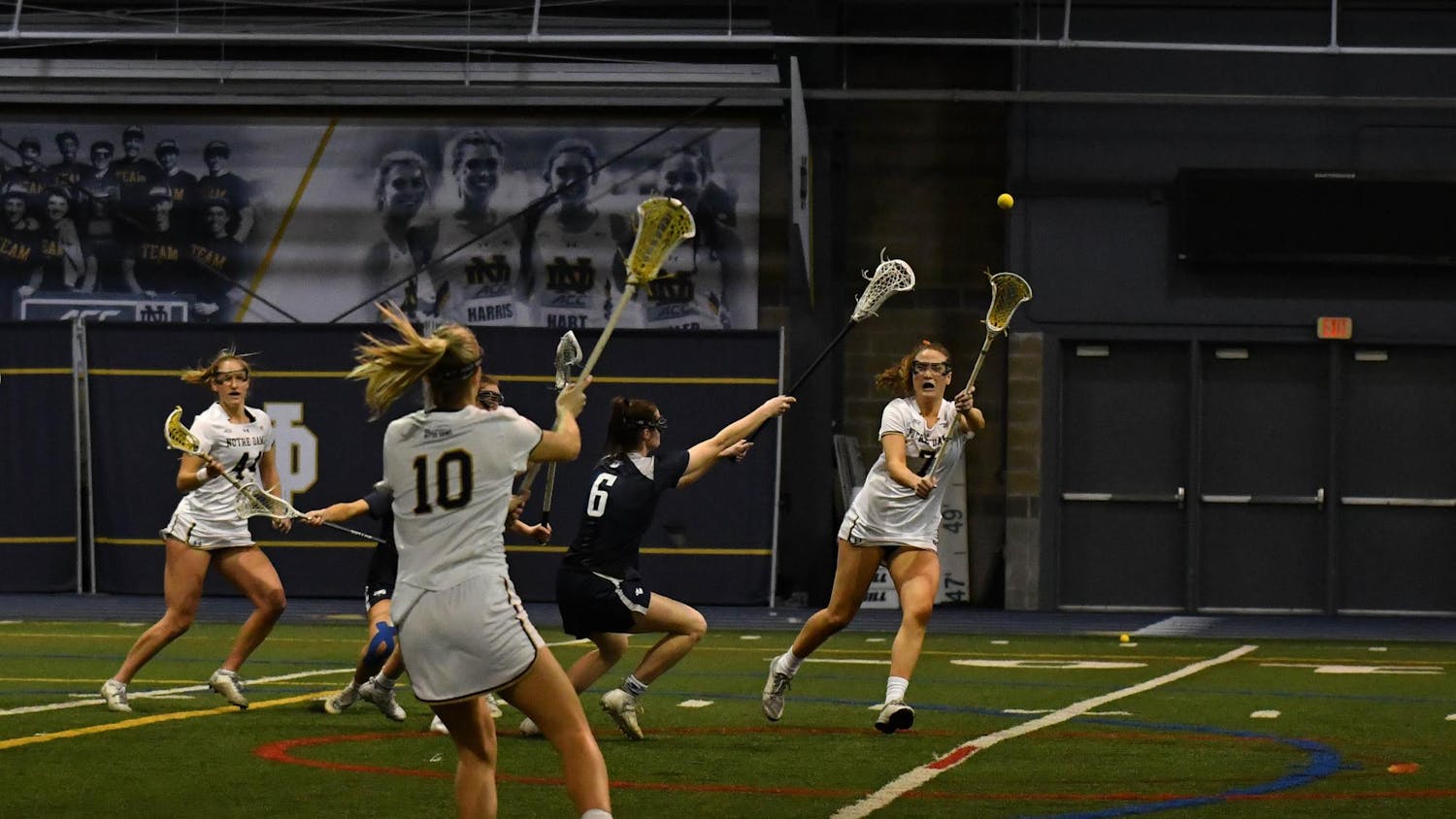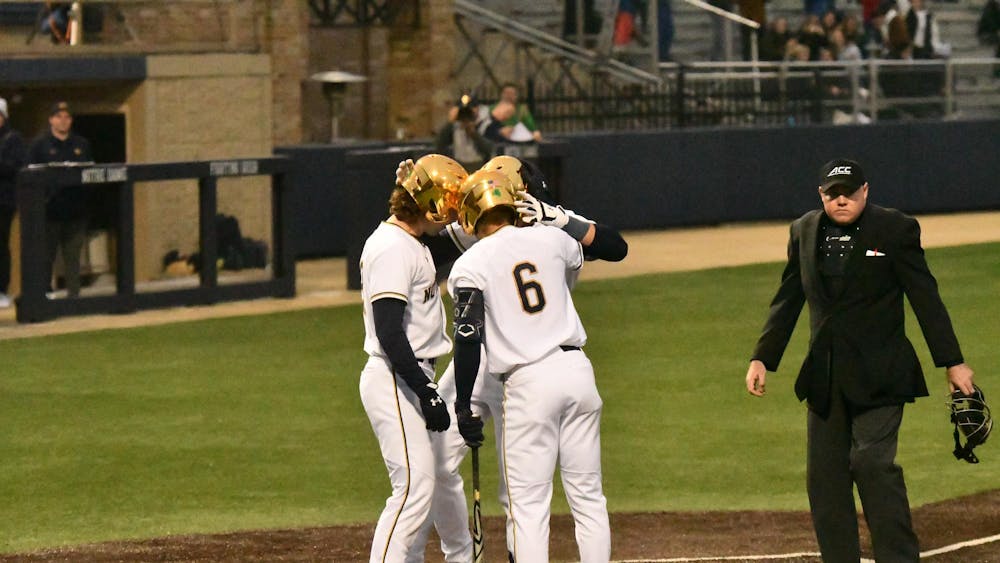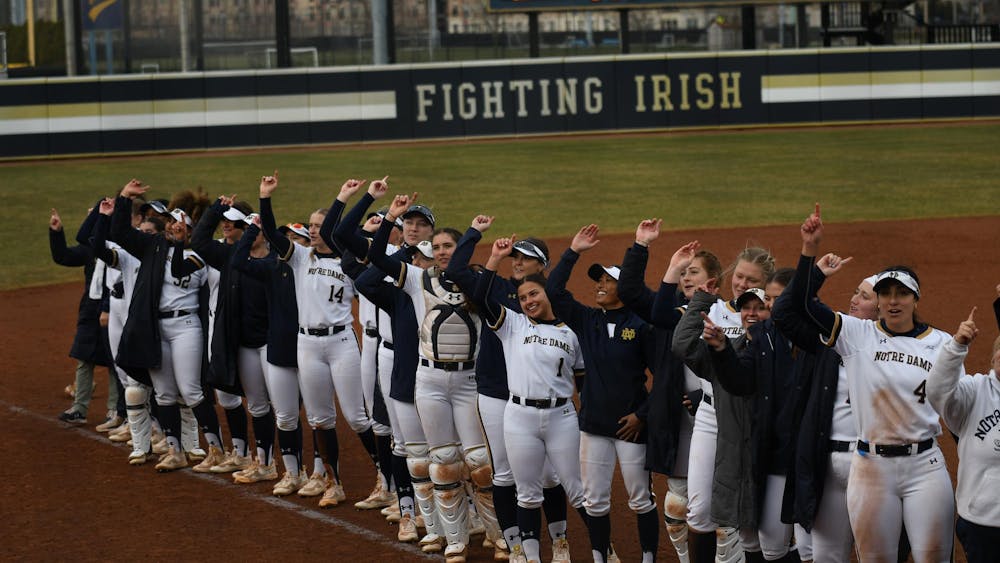
All things on the football field run through the offensive line, those five men in the middle without whom nothing can happen for the offense. They are constantly fighting and scrapping with no plays off.
No one is in the middle of the action more than the center. It’s a colossal burden to shoulder, and it’s a job Irish senior Matt Hegarty performs day after day.
It’s a responsibility he doesn’t take lightly.
“First and foremost, you gotta make sure you get the play started with the snap,” Hegarty said. “And then secondly, you got a guy on both sides. And if there’s a miscommunication, it falls back to you for not getting everyone on the same page.”
There’s a notably relaxed nature in how Hegarty describes his job. It’s an exhausting position, yet the way he presents it makes it seem like just another everyday routine, like remembering to tie your shoes.
That’s because, considering what he’s overcome, juggling plays and his leadership duties on the line all while handling a cagey defensive lineman in front of roaring fans is a walk in the park.
It was during Boston College week in mid-Nov. 2012 that Hegarty realized something was wrong. While most injuries or ailments for his position are relatively recognizable, this was different.
“We were in the weight room during the walkthrough, and I couldn’t talk,” Hegarty said. “I was trying to make calls on the line. Basically, the brain was thinking, but the mouth wasn’t moving.”
His teammates were quick to notice.
“We were about to get ready to go to practice, and I was still trying to talk to them,” Hegarty said. “I’m still having trouble with [the words]. But they didn’t really know what to think about it, and there they realized, 'Something’s wrong with Matt.’”
They notified the coaching staff, and Hegarty was sent to the hospital. By then, Hegarty's speech had returned, and the effects of whatever it was that had hit him were fading away enough for him to think that it was just a fluke. But still, he said he found himself thinking.
“What really scared me most was that I wasn’t sure, because this is such a wide range of things,” Hegarty said. “I was like ‘I’m young, it couldn’t be this or that or that.'”
In the middle of his attempts to figure out the problem, a possible diagnosis emerged.
“I’ve known people who’ve had strokes, and that was what this reminded me of,” Hegarty said. “Especially when I heard them describing trying to make a word.”
Did the thought cross his mind?
“Slightly,” Hegarty said. “But at the same time, I’m a realist. I’m thinking, ‘I’m in my 20s. This has got to be something else.’”
The next morning, Hegarty went in for an MRI to determine what had happened. After sitting in there for about an hour and a half (“I remember I had a cough stuck in my throat, and I couldn’t get it out. I just had to sit there,” he said), Hegarty said he emerged to hear the doctor tell him that he’d gotten off the phone with Matt’s mom, and she was flying out to be with him now.
He’d had a stroke.
“I was shocked,” Hegarty said. “It was surreal, especially since I was feeling so much better that I thought that whatever it was, it was done, and all I could think about was how soon do I get back out [on the field]. And now, I’m given a scale of just how big the picture was now.”
Hegarty’s stroke had been brought on by the presence of two small holes in his heart that had existed there, undetected since birth. He underwent surgery Dec. 14 to repair the damage.
With the rest of his season immediately ruled out, Hegarty said he did his best to stay involved with the team. He was always a presence on the sideline and traveled to Florida for the BCS National Championship Game. Of course, now there was more to juggle in addition to being a member of the Irish.
“I was going to team meetings, but I was also doing my rehab,” Hegarty said. “I worked out as much as I could, obviously with limitations on what I could and couldn’t do as far as pushing my heart.”
It was that dedication and commitment that got him to Notre Dame in the first place; it would be that same dedication and commitment that would get him through this. And in the midst of it all, he found an unlikely — but all too fitting — source of inspiration: Tedy Bruschi, retired New England Patriots linebacker.
“Tedy Bruschi is a perfect example,” Hegarty said. “He had a stroke when he was playing, and he wrote a book about it. My parents got it for me for that Christmas [after my stroke], and it was really powerful to read. Before I had mine, I had no idea about his, until [former Irish center] Braxton [Cave] said ‘Hey, isn’t that what Tedy Bruschi had?’ I started looking into it, and was like ‘Wow, this is kind of amazing.’
“The way I looked at it was that it wasn’t so much a case of me trying to climb this hill that’s impossible; but rather, he did it, and I don’t see why I can’t.”
Less than a year after that scary afternoon in the weight room, Hegarty returned to action in the spring of 2013, in time for the Blue-Gold Game.
“Initially, with spring ball, there were some nerves,” Hegarty said. “I remember thinking, ‘I’m fine.’ But when I was out there, I found myself thinking ‘Am I fine?’ I mean, I had thought I was fine before, but…”
At that point, he said the hardest hurdle to clear was in his head.
“I think it was definitely mental because, physically, I worked out as much as I could on the side,” Hegarty said. “I really wasn’t too worried about that, but the mental side was definitely frustrating because as much as you tell yourself you’re fine, I found myself having dreams where I’d hit a guy, and I knew something had gone wrong.
“I think really what helped there was the simple act of getting after it in practice.”
But nerves or not, Hegarty was back on the field for the Irish and proved right everyone who had believed he could make it back.
“I sincerely feel like that’s one of the biggest things that helped me get through it,” Hegarty said. “Teammates here and my family and people back home and people that have had strokes have reached out.”
That would be enough of a mountain to climb in and of itself, but several months into the season, injuries to the offensive line forced Hegarty to jump into the role of starter, against BYU on Nov. 23. It was the first game Hegarty had ever started.
“That was my first time really jumping in and taking the reins,” Hegarty said. “My first concern was, with the wind and the snow blowing, just to get the ball to [former Irish quarterback] Tommy [Rees], and the rest of it kind of worked itself out.”
But more importantly, there was something that wasn't on his mind.
“By that point, most of my nerves about my health were gone,” Hegarty said. “I had the spring under my belt, and we were three to four months into the season. I didn’t have time to be nervous about that. It was just, ‘Hey, I just gotta go out and do my job.'”
Now, as Hegarty prepares for the home stretch of season, he said he can look back on just what he’s overcome to get to this point and start thinking about the future. Hegarty, a management and consulting major in the Mendoza College of Business, said he knows that wherever the road takes him, he’s been fortunate to be where he is today.
“I think the nice part about being here is that you don’t really have to choose [a life without football,]” Hegarty said. “Obviously, I would like to play for as long as I can. My goal here is continue to get my education while I get myself the best opportunity to get ready for the next level. I know that in my back pocket, whenever the time comes that my career is over, I can look at a degree from Notre Dame. That’s really nice.”













